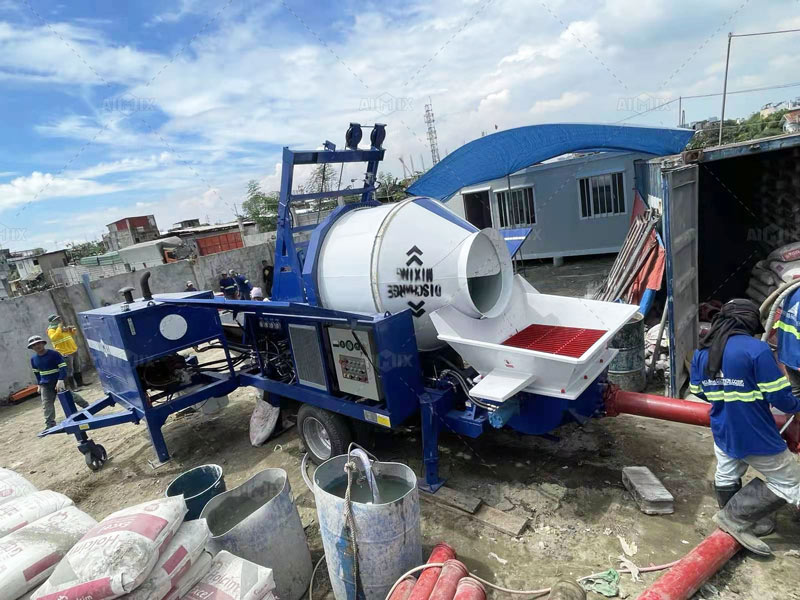Concrete pumps, whether they are concrete trailer pumps or truck-mounted models, are essential machines in construction projects. Like all heavy machinery, these pumps undergo wear and tear due to constant use, resulting in the need for regular maintenance and replacement of certain parts. Understanding the key wearing parts of concrete pumps and their reference replacement cycles is crucial for minimizing downtime and ensuring optimal performance throughout their lifecycle. In this article, we’ll explore the common wearing parts of concrete pumps and provide insight into their typical replacement cycles to help owners and operators make informed decisions.
Key Wearing Parts of Concrete Pumps
Concrete pumps operate under high pressure and constant stress, which causes certain components to wear faster than others. Regular maintenance and timely replacement of these parts are essential for ensuring smooth operations. The key wearing parts of concrete pumps(bomba de hormigón) include:

1. S-Valve
The S-valve is one of the most critical components in a concrete pump, controlling the flow of concrete through the system. It’s exposed to high wear due to constant contact with abrasive concrete materials. Over time, the S-valve may become deformed or damaged, leading to inefficient pumping and potential blockages. On average, the S-valve should be inspected every 500 to 1000 hours of operation, with a typical replacement cycle of 2 to 3 years, depending on usage and maintenance practices.
2. Wear Plates
Wear plates are used to protect the pump’s critical internal surfaces from damage caused by the abrasive nature of concrete. These plates are subject to high levels of friction and can degrade quickly, affecting the overall efficiency of the pump. For concrete trailer pumps(bomba estacionaria de hormigón) and other pump types, wear plates should be inspected regularly. They generally need to be replaced every 6 months to 1 year, or earlier if signs of significant wear are visible.
3. Piston Cups
Piston cups are crucial for creating the necessary pressure in the pumping system. These parts experience significant wear due to their constant motion and contact with concrete slurry. Piston cups should be checked for damage every 300–500 operating hours, with replacement cycles typically around 1–2 years, depending on the material of the piston cup and the abrasiveness of the concrete being pumped.
4. Delivery Cylinder
The delivery cylinder is responsible for transporting the mixed concrete to the construction site. It is exposed to a lot of stress and pressure, leading to eventual wear. The delivery cylinder typically requires inspection every 500 operating hours, with a replacement cycle of 2–3 years, depending on usage and environmental conditions.

Factors Affecting the Replacement Cycle of Concrete Pump Parts
The replacement cycle of concrete pump components is influenced by several factors, including the type of pump, operating conditions, and the maintenance practices in place. Below are some key factors that affect the wear and tear of concrete pumps:
1. Concrete Quality
The quality of the concrete being pumped plays a major role in the rate of wear on the pump components. Concrete with higher abrasive content, such as mixes containing more aggregate, will wear out parts more quickly. Therefore, it’s essential to choose the right price of concrete pump(bomba de concreto precio) and specifications based on the types of concrete that will be pumped most frequently.
2. Operating Environment
Environmental conditions such as temperature, humidity, and dust levels can also impact the replacement cycle of concrete pump parts. Pumps working in extreme conditions, such as high temperatures or in areas with high dust levels, may experience faster wear and tear. This makes regular inspections even more critical in harsh environments.
3. Maintenance Practices
Adhering to a proactive maintenance schedule can greatly extend the life of the wearing parts. Regular lubrication, cleaning, and timely inspections can help identify problems early and prevent the need for premature replacements. It’s also important to use high-quality lubricants and materials recommended by the manufacturer to minimize wear.
4. Pump Type and Usage
The type of concrete pump being used—whether it’s a concrete trailer pump or a truck-mounted pump—also affects the replacement cycles. Truck-mounted pumps generally work under more demanding conditions and may require more frequent part replacements. Additionally, pumps that are used heavily or for long continuous hours will naturally experience more wear compared to those used for shorter periods.
How to Maximize the Lifespan of Concrete Pump Components
Maximizing the lifespan of wearing parts in concrete pumps(bombas de hormigón chile) requires proper care and attention. Below are some best practices for maintaining concrete pump parts:
- Regular Inspections: Regularly inspect key components like the S-valve, wear plates, piston cups, and delivery cylinders for signs of wear. Early detection of issues can prevent costly downtime.
- Proper Lubrication: Ensure that all moving parts are properly lubricated to reduce friction and wear. Use only the recommended lubricants and fluids for your pump model.
- Cleaning: Thoroughly clean the pump after each use to remove concrete buildup, which can cause wear and blockages over time.
- Quality Concrete Mixes: Using high-quality concrete with an optimal mix of aggregates can reduce the abrasiveness and extend the life of the pump.
- Adhere to Manufacturer Guidelines: Always follow the manufacturer’s recommendations for maintenance and replacement cycles to ensure that your pump operates efficiently for years to come.
Conclusion
Understanding the wearing parts of a concrete pump and their reference replacement cycles is essential for contractors looking to keep their pumps in optimal condition. Regular maintenance and timely replacement of critical parts like the S-valve, wear plates, piston cups, and delivery cylinders can help prevent costly repairs and reduce downtime. Whether you are using a concrete trailer pump or a truck-mounted model, adhering to a regular inspection and maintenance schedule is key to extending the lifespan of your concrete pump and ensuring its efficient operation.